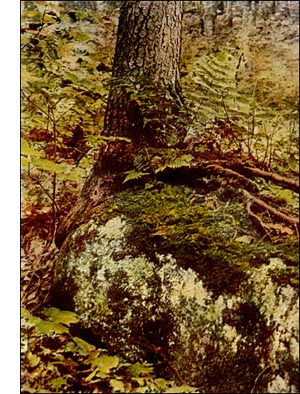Dotted Mnium Moss
 The Dotted Mnium, Mnium punctatum, Hedw.
The Dotted Mnium, Mnium punctatum, Hedw.Habit and habitat.-The Dotted Mnium may be looked for about cold springs and along the borders of mountain brooks.
It grows in loose dark or yellowish green tufts, each plant standing stiff and erect with rusty-brown hairs.
The leaves are large, not very close together on the stem and of a delicate translucent green. A hand lens will show them to have a hard, brown, entire margin notched at the rounded apex, and a tiny little point in the notch.
The fruits are not often found, but when present are oval, green cylinders with sharp-pointed lids, horizontal or inclined on slender pedicels.
Name.-The specific name, the Latin punctatum, dotted, was given by J. G. Hedwig, on account of the cell structure.
Plant (gametophyte).-Tall, robust, 3 to 6 inches high, the dark-green sterile shoots erect; all covered the whole length with brown filaments.
Leaves.-Remote on branches and stems, open, turned back from the stem, large, the lower round, oval, inserted on by the enlarged vein; the tipper 4 to 6 in a rosette, each leaf broadly oval, tapering toward the base; apex slightly notched, with a sharp point in the notch; margin entire, brown, thick and hard; vein purplish, abruptly vanishing near apex, extending down the stem.
Habit of flowering.-Male and female flowers on separate plants (dioicous) ; male plants more slender than the female, with but few stem leaves, and the leaves at the summit arranged as a rosette about the male flowers (antheridia).
Veil (calyplra).-Split up one side, remaining on the sporecase all winter but falling early in the spring.
Spore-case.-Oval, green when mature, brown when older, ovate-oblong, somewhat pendulous, finally horizontal.
Pedicel.-Long and pale, usually solitary.
Lid (operculum).-Acutely beaked.
Annulus.-Narrow, rolling back as the lid is pushed off.
Teeth (peristome).-As in the genus.
Spores.-Mature in spring.
Distribution.-America, Europe, Asia.